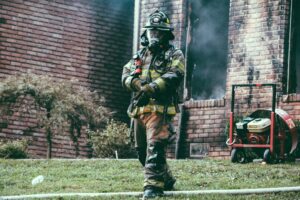LEDs And Fire Safety
Posted by Emma Reid on 27th Apr 2022

12% of all fires in the UK are caused by electrical appliances. How do LEDs factor into this?
According to government statistics, in 2020/21 there were 27,021 dwelling fires in the UK with 186 fire-related deaths. Fire can strike at any time, and cause a huge amount of devastation even if they don’t result in a fatality.
With 12% of all fires being caused by faulty electrical appliances, it’s important to use the most up-to-date technology possible wherever you can.
Filament Bulbs Run Hot
Older style filament bulbs (such as incandescent and halogen bulbs) produce light as a result of generating heat. They heat a filament to such a point that they start to glow (known as incandescing!)
Not only is this fairly inefficient (incandescents use 80% of their energy to generate heat, and halogens are only a small improvement) it also means that these bulbs get incredibly hot. LEDs, by contrast, use 90% of their energy generating purely light, so they can run a lot cooler.
How much cooler? After 3 minutes of operation, an incandescent bulb will reach around 216°C.
An LED bulb will reach around only 32.6°C.
Contact fires are one of the most common ways for fires to start. If a bulb reaches a high temperature and is then kept close to something flammable (most famously curtains and drapes, but also other combustible items), this flammable item will slowly reach its ignition point, catching fire.
Since they run so cool, this risk is massively reduced by LEDs!
Faulty Wiring
Contact heat is one of the most common causes of house fires, but it’s not the only one. Improperly installed electrical systems can also cause problems.
LEDs are sophisticated pieces of technology, which means they need to be installed carefully, or else they can become a fire risk. Here are three simple steps you can take to mitigate this risk.
- Ensure your bulb is of high quality.
- Avoid using LEDs in enclosed fittings.
- If you have enclosed fittings in your home, buy LEDs that are ‘Enclosed Fixture Rated’.
- Ensure the bulb is the right wattage for the fixture.
Fire Rated Lights
So if LEDs are so much less of a fire hazard, why do we need fire-rated downlights?
Cutting into your ceiling can significantly increase the risk of fire spreading throughout your home. Even if your lights look well fitted, there will still be small gaps through which fire, smoke and heat can spread quickly.
Modern fire rated downlights are equipped with pads that swell when they reach a certain temperature. This blocks off those small gaps and forces any fires to take time to find a way around.
Armed with this knowledge, improve safety in your home with our LED bulbs! Got any questions about LED lighting? Our team are on hand to help you with anything you need – simply give us a call on 0116 321 4120, or send an email over to cs@wled.co.uk!
Don’t forget that you can keep up to date with all our latest news and products by taking a look at our Facebook and Instagram pages, and a follow on our Twitter feed! You can also subscribe to our YouTube channel.





